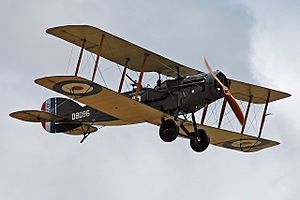Bruce Digby-Worsley facts for kids
Quick facts for kids
Ernest Bruce Digby-Worsley
|
|
|---|---|
| Born | 6 February 1899 Gloucester, Gloucestershire, England |
| Died | 19 February 1980 (aged 81) Hastings, Sussex, England |
| Allegiance | |
| Service/ |
|
| Years of service | 1914–1919 |
| Rank | Second Lieutenant |
| Service number | 31094 |
| Unit | Gloucestershire Regiment Middlesex Regiment King's Own Scottish Borderers Royal Flying Corps No. 88 Squadron RAF |
Second Lieutenant Bruce Digby-Worsley was a brave British flying ace during World War I. A flying ace is a military pilot who shoots down five or more enemy aircraft. He achieved an amazing 16 victories in the air between June and September 1918.
Early Life and Joining the War
Ernest Bruce Digby-Worsley was born in Gloucester, England, on February 6, 1899. He passed away in 1980 in Hastings, England. When he joined the army in 1914, he was only 15 years old. He was still a schoolboy living at home.
To join the army, Bruce pretended he was 19. He lied about his age and even where he was born! He joined a local army group called the Territorial Force.
In 1916, Bruce was sent back from France to a hospital in Gloucester. He had a serious condition called trench foot. This happens when feet are in cold, wet conditions for too long. He had only been serving in Flanders for two months.
After this, Bruce's mother tried to get him out of fighting. She said he was too young for the front lines. But by then, Bruce had become a drill instructor. This meant he trained new soldiers. The army felt they needed him to help train recruits at home. He did this until he moved to a different army group.
After the war, Bruce had a successful career in theatre. He became a manager for famous places like the Sadler's Wells Theatre.
Bruce's Military Adventures
Bruce Digby-Worsley joined the army on September 21, 1914. He served in different army groups. In August 1917, he joined the Royal Flying Corps as an officer trainee. He officially became an officer on January 3, 1918. He was a probationary second lieutenant.
In April 1918, Bruce returned to France. He joined No. 88 Squadron of the Royal Air Force. On July 24, 1918, his rank as second lieutenant was confirmed. He served as an observer officer. An observer in a World War I plane helped the pilot. They looked for enemy planes and used machine guns.
Bruce is famous for his 16 aerial victories. All of these happened while he was an observer in a Bristol F.2b plane. He achieved all his victories in just four months!
His first four victories were with Lieutenant Kenneth Conn as the pilot. Kenneth was from Canada. On June 5, 1918, Bruce scored two victories in one day! He destroyed two Albatros D.V planes over Messines, Belgium. The next month, on July 1, 1918, he got two more victories. He took out two Fokker D.VII planes. One burst into flames, and the other spun out of control.
His next seven victories were with Lieutenant Charles Findlay as the pilot. Charles was a Scottish flying ace. On July 30, 1918, Bruce got his fifth victory. He sent a Pfalz D.III plane out of control over France. His sixth victory was on August 6, 1918. A Fokker D.VII was destroyed in flames over Ploegsteert, Belgium. This place was important to Bruce. His cousin had been killed there earlier in the war.
On August 11, 1918, Bruce had an amazing day. He achieved four victories! In the morning, he sent two Fokker D.VII planes out of control. In the afternoon, he took out two more D.VII planes. One was destroyed in flames, and the other spun out of control. His eleventh victory was the next day, August 12, 1918. He destroyed a Fokker D.VII plane.
Bruce's last five victories were again with Kenneth Conn as the pilot. Kenneth was the top ace of their squadron, with 20 victories. Bruce's twelfth victory was on September 5, 1918. He sent a Fokker D.VII out of control. On September 16, 1918, he scored two more victories. He destroyed two Fokker D.VII aircraft. Four days later, on September 20, 1918, Bruce got two more victories. He sent one Fokker D.VII out of control and destroyed another. This last one was his sixteenth and final victory.
The person Bruce shot down in his sixteenth victory was Leutnant Helmut Gantz. He died from his injuries the next day. This last victory was also shared with four other airmen. They were Captain Edgar Johnston, Lieutenant Walter Grant, Lieutenant George Poole, and Sergeant Charles Hill. These men were also flying aces.
Bruce Digby-Worsley left the army on April 26, 1919. This was because of an illness he got while serving. He was allowed to keep his rank as second lieutenant.
See also
- Aerial victory standards of World War I


